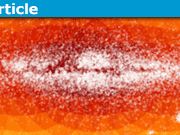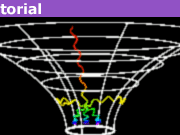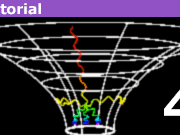Will All Matter Be Converted to Photons?
Table of Contents
Will all matter be converted into black holes and then photons?
No. There is a misconception that a lot of laypeople seem to be picking up recently from popularizations, which is that all the matter in the universe will first be sucked into black holes, and then recycled into photons in the distant future through Hawking radiation so that the only thing left will be photons. This is wrong.
First, let’s talk about the black hole part. Physicists have done detailed calculations of this kind of thing. Black holes are not super-powerful cosmic vacuum cleaners that can suck in everything there is. When a black hole forms through gravitational collapse, such as the collapse of a dying star, its mass stays the same, and that means that at some fixed distance such as a billion kilometers, its gravity is no stronger than it used to be. A black hole is a very small object, typically about the size of a city. This makes it a small target, and the space between the stars is vast, so a huge amount of luck is required if it is to swallow another astronomical object through a chance collision. This will sometimes happen, but before it can happen to most stars, they will end up being scattered out of their galaxies and galaxy clusters, after which cosmological expansion will keep them permanently safe from being eaten.[Adams 1997],[Baez 2004]
This process of disintegration is not restricted to galaxies. In the long run, all material objects are expected to disintegrate into subatomic particles through a variety of thermal and quantum-mechanical fluctuations, although some of the processes are expected to take extremely long times. [Baez 2004]
These calculations are not controversial and are not based on speculative physics. There are strong reasons to believe in them, because one of the world’s most talented physicists, Roger Penrose, has a pet theory called CCC[Penrose 2008] that is hard to reconcile with them, and he has spent a great deal of time and effort trying to to find a mistake or a loophole in them. He couldn’t and was reduced to proposing various other workarounds involving speculative particle physics (such as massless charged particles), which didn’t work out.
So if we look at the cosmic cereal box a gazillion years from now, what will be on the list of ingredients? It will contain stable, massive subatomic particles such as electrons.[Baez 2004] (The exact roster of particles depends on unknown particle physics such as dark matter and proton decay.) Any photons with ordinary energies, such as those originating from the present-day cosmic microwave background, will play a negligible role as their energy density becomes diluted faster than the mass-energy density of material particles. (This process has already been going on for billions of years. It is the reason why the cosmic microwave background, which was dominant in the early universe, is now a negligible part of the universe’s mass energy.) However, the universe will contain photons with extremely low energies, which an observer (if one could be present and could detect them) would describe as Hawking radiation from the cosmological event horizon.[Hu 2011] These photons will have a temperature on the order of 10^-30 K, meaning a typical energy of 10^-34 eV and a wavelength of 10^28 m.
Sources
Adams and Laughlin, “A Dying Universe: The Long Term Fate and Evolution of Astrophysical Objects”, Rev. Mod. Phys. 69 (1997) 337,http://arxiv.org/abs/astro-ph/9701131
Baez, “The End of the Universe,” 2004, http://math.ucr.edu/home/baez/end.htmlPenrose, Causality, quantum theory and cosmology. In On Space and Time, ed. Shahn Majid, Cambridge University Press, Cambridge, 2008, pp. 141-195. (ISBN 978-0-521-88926-1)Hu, “Hawking radiation from the cosmological horizon in an FRW universe,” Phys. Lett. B701 (2011) 269-274, http://arxiv.org/abs/1007.4044
Forum Post: https://www.physicsforums.com/threads/will-all-matter-be-converted-to-photons.826386/
PhD in physics. I teach physics at Fullerton College, a community college in Southern California. I enjoy writing, playing viola, brewing beer, climbing and mountaineering.








“Photons are but one of the force carriers, IMO, I don’t see why matter would decay to wandering photons.”
The only thing I would point out in addition to what Drakkith said in #35 is the following. People who believe, incorrectly, that all matter will be converted to photons seem to believe that the mechanism of conversion is that all matter gets eaten by black holes and recycled via Hawking radiation. Hawking radiation does in principle include all kinds of particles other than photons. However, these other particles have nonvanishing mass ##m##, and the Hawking radiation’s temperature is normally much less than ##mc^2/k##, so the probability of emitting these particles is ordinarily very small. So if you believed, incorrectly, that all matter gets recycled, then it would make sense to believe that almost all of the resulting stuff would be photons.
“Photons are but one of the force carriers, IMO, I don’t see why matter would decay to wandering photons.”
Essentially all decay mechanisms would eventually lead to the creation of photons and leptons. They are the least massive, stable particles and have nothing else they can decay to and still obey conservation laws.
“As long as an attractive force is in place particles will be attracted to other particles forming matter/anti-matter or energy.”
That might be true if it weren’t for the expansion of the universe. Below a certain density expansion would keep pretty much any two particles from being pulled together under gravity.
“The opposite affect is the total collapse into one dark object, it may have already happened (insert big bank text here).”
Are you referring to the Big Crunch?
Photons are but one of the force carriers, IMO, I don’t see why matter would decay to wandering photons.
How far would the universe have to expand to allow all particles to just spread out even to decay just to helium or sub particles.
As long as an attractive force is in place particles will be attracted to other particles forming matter/anti-matter or energy.
The opposite affect is the total collapse into one dark object, it may have already happened (insert big bank text here).
We know it is, the amount of antimatter is tiny in our universe.
But even if it wouldn’t, expansion of the universe spreads out the different particles so fast that there would not be a complete annihilation any more.
”
[SIZE=4]This process of disintegration is not restricted to galaxies. In the long run, all material objects are expected to disintegrate into subatomic particles through a variety of thermal and quantum-mechanical fluctuations, although some of the processes are expected to take extremely long times.[Baez 2004]
…
So if we look at the cosmic cereal box a gajillion years from now, what will be on the list of ingredients? It will contain stable, massive subatomic particles such as electrons.[Baez 2004] (The exact roster of particles depends on unknown particle physics such as dark matter and proton decay.)
…[/SIZE]
”
Please clarify a point concerning matter-antimatter. Does that scenario not assume that the net universal count of leptons, quarks etc is non-zero? And if so, do we have any basis for assuming this is so? (I am not asserting or hoping anything in particular; this is just a question without baggage, either emotional or theoretical.)
I like your discussion. I could only add speculation about the proton, in which case it would possibly allow violation of the baryon number seemingly. It would use the expansion of our universe and multiply anti-baryons to compensate. This utilization of dark energy would become the source of mass and the conversion of dark energy’s quantum states, reducing the expansion of the universe. We at present have the ability to use positive energy to break apart the proton in this collision process using positive kinetic energy ( momentum ) happens in one vector, however dark energy has 6 degrees of freedom. If we torque the gluons through the expansion of space-time we could conserve structure and convert energy sources. Thank you.
”
For the ultimate photon fate of the universe we need to have:
Black holes as singularities, which is not the best of models, gravastar being a nice contender (purely personal opinion).
Hawking radiation, no physical evidence thus far.
Dark energy, which accelerates stuff, yet all our observations are of horribly past events.”
You’re certainly right that all of this stuff requires brave extrapolations that may be wrong. However, the FAQ is not “What is the ultimate fate of the universe?” but “Will all matter be converted to photons?,” which is much more restricted. The answer is no, and I don’t think any of the things you list have any effect on that. Whether or not a black hole has a singularity inside it has no effect on the outside universe. If Hawking radiation doesn’t exist (or if black hole event horizons don’t exist), that would eliminate one of the possible mechanisms for converting matter into photons, and the answer would be an even more conclusive no. Although the evidence for accelerating cosmological expansion and dark energy is in fact much stronger than you appear to believe, if it turned out to be wrong, that wouldn’t change the result; in fact, the paper by Adams and Laughlin was written before cosmological acceleration was discovered, but they conclude the same thing.
“I didn’t think there was any experimental evidence for proton decay. What mechanisms turn baryonic matter into something else?”
Right, there’s some pretty strong theoretical motivation, but no empirical evidence. As noted in #1, this only changes the detailed composition of the matter that we end up with. It doesn’t change the ‘no” answer to the question posed. IIRC scenarios with and without proton decay are discussed in some detail in the Adams-Laughlin paper.
There is no experimental evidence, but there are good arguments that a decay should be possible. There is no particular reason why baryon number should be conserved exactly, and we know that the early universe needed some violation (as we have baryons around but nearly no antibaryons). Any process that can change the baryon number can lead to a proton decay.
Even if the other interactions don’t have a mechanism, gravity should have one: a decay via a virtual black hole.
All those mechanisms lead to proton lifetimes orders of magnitude above the current experimental lower bounds, however. A detection of proton decay with current detectors would be something new.
I didn’t think there was any experimental evidence for proton decay. What mechanisms turn baryonic matter into something else?
“Then again there may be future discoveries which involve other as yet unknown physics and the answer could be something else.”
Good point.
For the ultimate photon fate of the universe we need to have:
Black holes as singularities, which is not the best of models, gravastar being a nice contender (purely personal opinion).
Hawking radiation, no physical evidence thus far.
Dark energy, which accelerates stuff, yet all our observations are of horribly past events.
‘Will all matter be converted to photons?’ = was the original question.
In the sense of is this final state of the Universe>
I am inclined to to say it seems to be more likely than not, given the standard model at present.
Then again there may be future discoveries which involve other as yet unknown physics and the answer could be something else.
no you r wrong praveena..you should learn about quantm physics and energy laws befor saying that..
“Thank you”
no..as my starter brother said was right and m totally agree with him..
Mfb, this might make an interesting topic for a separate thread, but I don’t think it has much to do with the present subject.
Well, the earth is a single massive object already. That’s what I meant with trivial cases.
Its non-ellipsoidal shape still leads to some emission, but that is really negligible and will go away over time as soon as the geologic activity dies down (assuming the earth does not fall into the sun earlier).
“How would such a stable (and non-trivial) system look like?”
I don’t think there are stable systems in which gravity is the only force. But for example the earth is a gravitating system stabilized by nongravitational forces, and the earth doesn’t radiate gravitational waves, even though it contains accelerating massive particles. Because of its symmetric shape, the earth’s mass quadrupole moment doesn’t change, so there is no radiation.
“Right, but that is a non-trivial observation.
How would such a stable (and non-trivial) system look like?”
I would also like the answer to this. The only case I know of certainly doesn’t occur in our universe – a radially vibrating body with perfect spherical symmetry. It is well known that all binary systems eventually decay (via GW) to mutual collision unless something else happens first (very likely). It seems hard to believe a galaxy could have any magical symmetry to avoid this. Thus, this seems like a perfectly valid ‘if nothing else happens, then you get one black hole anyway’ argument.
That does not make sense.
“How does a gravitational waves would eventually let everything fall into the central black hole? They are just waves. you assuming that these waves are likes sea waves?which comes forth and move backwards?”I think it’s wave, just like sea waves. But they don’t come forth and backward. The “backward” effect is the bouncing of the wave to the beach.
“But B isn’t what happens either, since scenario C (scattering out) turns out to occur on much shorter time scales than decay of orbits by radiation.”Right, but that is a non-trivial observation.
“because you can have gravitating systems that don’t radiate due to their symmetry.”How would such a stable (and non-trivial) system look like?
“Well, it cannot stay in the same state, if nothing else would happen the emission of gravitational waves would eventually let everything fall into the central black hole.”
I see. But this still doesn’t seem particularly relevant to me. It distinguishes scenario A (permanent stability) from scenario B (collapse to a single black hole via gravitational radiation) and describes why A can’t happen. But B isn’t what happens either, since scenario C (scattering out) turns out to occur on much shorter time scales than decay of orbits by radiation. It might be of some theoretical interest if you wanted to prove some kind of general theorem about the instability of systems in GR, but then there would be more to do to complete the argument, because you can have gravitating systems that don’t radiate due to their symmetry. (Something similar happens with systems of particles interacting electromagnetically. They can’t be stable, but proving it in general is nontrivial, because acceleration isn’t a sufficient condition for radiation.)
Orbiting bodies emit gravitational waves and lose energy in the process, which makes their orbits get closer over time.
This is an incredibly slow process for stars orbiting a galaxy, but it is notable in close binary systems. [url=https://en.wikipedia.org/wiki/PSR_B1913%2B16]PSR B1913+16[/url] is the most famous system, [url=https://en.wikipedia.org/wiki/PSR_J0737-3039]PSR J0737-3039[/url] is even better to study.
“Well, it cannot stay in the same state, if nothing else would happen the emission of gravitational waves would eventually let everything fall into the central black hole.”
How does a gravitational waves would eventually let everything fall into the central black hole? They are just waves. you assuming that these waves are likes sea waves?which comes forth and move backwards?
“I don’t follow you here. This might explain why we can’t have a central black hole eat up its entire host galaxy, but that would have never occurred to me in the first place as a plausible possibility. I think what most people would expect would be that the galaxy would continue to be bound and stay in pretty much the same state — which isn’t what happens, for the reasons explained in #7 and in the Baez article.”Well, it cannot stay in the same state, if nothing else would happen the emission of gravitational waves would eventually let everything fall into the central black hole.
“So this calculation also include ‘dark matter’? That is supposedly bound celestial bodies to revolve around the Galaxy centre. Or ‘dark matter’ only hold galaxies to orbit the centre of the supercluster, not stars to orbit SMBH?”
The scattering of matter out of a gravitationally bound system follows from very basic considerations relating to statistical mechanics, as described in #7 and the Baez article. It doesn’t matter whether the matter is in the form of stars or dark matter.
“Conservation of angular momentum gives a good argument why most stars have to get ejected: a single massive black hole has a tiny angular momentum, so most angular momentum has to leave the galaxy.”
I don’t follow you here. This might explain why we can’t have a central black hole eat up its entire host galaxy, but that would have never occurred to me in the first place as a plausible possibility. I think what most people would expect would be that the galaxy would continue to be bound and stay in pretty much the same state — which isn’t what happens, for the reasons explained in #7 and in the Baez article.
Ahh, I can’t edit or delete my post:
MFB has answered it:
“Conservation of angular momentum gives a good argument why most stars have to get ejected: a single massive black hole has a tiny angular momentum, so most angular momentum has to leave the galaxy. This happens via ejecting radiation (negligible), mass (!) and gravitational waves. Gravitational waves are important in the direct vicinity of the black hole, but negligible for objects somewhere else in the galaxy.”
“[SIZE=4]FAQ: In the very distant future, will all matter be converted into black holes and then photons?[/SIZE]
“I’m somewhat flattered by this featured thread. It’s less than three days before this that I post: [URL]https://www.physicsforums.com/threads/heat-death-of-the-universe.825752/#post-5186170[/URL]
And this thread addresses exactly my point: Will all matters sucked to form a single black hole and then evaporated through Hawking radiation into photon.
“First let’s talk about the black hole part.[..]This will sometimes happen, but before it can happen to most stars, they will end up being scattered out of their galaxies and galaxy clusters, after which cosmological expansion will keep them permanently safe from being eaten.[Adams 1997],[Baez 2004]”
So the orbit of the celestial bodies are not deterioting?
So this calculation also include ‘dark matter’? That is supposedly bound celestial bodies to revolve around the Galaxy centre.
Or ‘dark matter’ only hold galaxies to orbit the centre of the supercluster, not stars to orbit SMBH?
Conservation of angular momentum gives a good argument why most stars have to get ejected: a single massive black hole has a tiny angular momentum, so most angular momentum has to leave the galaxy. This happens via ejecting radiation (negligible), mass (!) and gravitational waves. Gravitational waves are important in the direct vicinity of the black hole, but negligible for objects somewhere else in the galaxy.
“(Can’t edit for some reason),
The radiation is the result of quantum effects at the event horizon.
The wiki article about it seems to be reasonable.
[URL]https://en.wikipedia.org/wiki/Hawking_radiation[/URL]”
Thank you
(Can’t edit for some reason),
The radiation is the result of quantum effects at the event horizon.
The wiki article about it seems to be reasonable.
[URL]https://en.wikipedia.org/wiki/Hawking_radiation[/URL]
While there is still infalling matter a black hole will continue to grow in mass and it’s associated gravity increases.
It’s quite possible though that a black hole after a very long time will eventually clear out most other material in it’s region, it has nothing left to consume.
According to Stephen Hawkins it should at that point very gradually start losing overall mass due to a form of radiation.
Can i know the power of gravitational force at the black hole will never get reduced while it consumes many subbatomic particles?
“I don’t know. If the cosmological constant is true, then everything but photons will dilute away to nothing (so that there is at most one massive particle per Hubble volume, with most containing no massive particles).
Protons will decay (leaving no solid objects). Black holes will evaporate. That leaves electrons, neutrinos, dark matter, and photons. Bound objects will eventually dissipate through some combination of annihilation and gravitational interactions. Particles not bound to gravitational potentials should, given a cosmological constant, eventually become the only particle in their horizon.
Photons should remain (at an exceedingly low temperature) due to Hawking radiation from the cosmological horizon.”
Thanks for your comments. I think you’re right. I need to modify my statements. It is not true, as I stated, that massive particles dominate the mass-energy density of the final state of the universe. However, it is true that stable, massive particles continue to exist.
Re this, “Particles not bound to gravitational potentials should, given a cosmological constant, eventually become the only particle in their horizon,” you can actually omit the qualifying phrase at the beginning. Gravitationally bound systems will still (counterintuitively) evaporate. This is discussed in the Baez article and also in #7.
“That’s interesting. Could you say briefly how most (presumably mostly dead) stars eventually get ejected from whatever gravitationally bound structures like galaxies and galaxy clusters? […] Would one of these references explain the process of ejection?”
Yes, the Baez article explains it briefly. See “(It may seem odd…”
I think it’s closely analogous to a counterintuitive fact about thermodynamics, which is discussed in Peierls, Surprises in theoretical physics, p. 55. Consider an isolated galaxy in infinite space. If there were an equilibrium state, the galaxy would be recapturing stars and losing them at equal rates. Note that fluctuations can always kick out a star, because there is no impediment due to conservation of energy. You can always reduce the PE to any extent you like by bringing some of your stars sufficiently close together. So the rate of loss is never zero. But the rate of recapture decreases with the volume of the surrounding space, and approaches zero as the volume approaches infinity. Therefore there can never be an equilibrium state.
Numerical work!
[URL]http://arxiv.org/abs/astro-ph/0310505[/URL]
[SIZE=6]Future Evolution of the Intergalactic Medium in a Universe Dominated by a Cosmological Constant[/SIZE]
[URL=’http://arxiv.org/find/astro-ph/1/au:+Nagamine_K/0/1/0/all/0/1′]Kentaro Nagamine[/URL], [URL=’http://arxiv.org/find/astro-ph/1/au:+Loeb_A/0/1/0/all/0/1′]Abraham Loeb[/URL] (Harvard-CfA)
(Submitted on 17 Oct 2003 ([URL=’http://arxiv.org/abs/astro-ph/0310505v1′]v1[/URL]), last revised 29 Mar 2004 (this version, v2))
We simulate the evolution of the intergalactic medium (IGM) in a universe dominated by a cosmological constant. We find that within a few Hubble times from the present epoch, the baryons will have two primary phases: one phase composed of low-density, low-temperature, diffuse, ionized gas which cools exponentially with cosmic time due to adiabatic expansion, and a second phase of high-density, high-temperature gas in virialized dark matter halos which cools much more slowly by atomic processes. The mass fraction of gas in halos converges to ~40% at late times, about twice its calculated value at the present epoch. We find that in a few Hubble times, the large scale filaments in the present-day IGM will rarefy and fade away into the low-temperature IGM, and only islands of virialized gas will maintain their physical structure. We do not find evidence for fragmentation of the diffuse IGM at later times. More than 99% of the gas mass will maintain a steady ionization fraction above 80% within a few Hubble times. The diffuse IGM will get extremely cold and dilute but remain highly ionized, as its recombination time will dramatically exceed the age of the universe.
Comments: 22 pages, 10 figures. Accepted to New Astronomy. Movies and a higher resolution version of the paper are available at [URL=’http://cfa-www.harvard.edu/~knagamine/FutureIGM’]this http URL[/URL]
[URL]http://arxiv.org/abs/astro-ph/0204249[/URL]
[SIZE=6]Future Evolution of Nearby Large-Scale Structure in a Universe Dominated by a Cosmological Constant[/SIZE]
[URL=’http://arxiv.org/find/astro-ph/1/au:+Nagamine_K/0/1/0/all/0/1′]Kentaro Nagamine[/URL], [URL=’http://arxiv.org/find/astro-ph/1/au:+Loeb_A/0/1/0/all/0/1′]Abraham Loeb[/URL] (Harvard-CfA)
(Submitted on 15 Apr 2002 ([URL=’http://arxiv.org/abs/astro-ph/0204249v1′]v1[/URL]), last revised 12 Nov 2002 (this version, v3))
We simulate the future evolution of the observed inhomogeneities in the local universe assuming that the global expansion rate is dominated by a cosmological constant. We find that within two Hubble times (~ 30 billion years) from the present epoch, large-scale structures will freeze in comoving coordinates and the mass distribution of bound objects will stop evolving. The Local Group will get somewhat closer to the Virgo cluster in comoving coordinates, but will be pulled away from the Virgo in physical coordinates due to the accelerated expansion of the Universe. In the distant future there will only be one massive galaxy within our event horizon, namely the merger product of the Andromeda and the Milky Way galaxies. All galaxies that are not gravitationally bound to the Local Group will recede away from us and eventually exit from our event horizon. More generally, we identify the critical interior overdensity above which a shell of matter around an object will remain bound to it at late times.
Comments: Accepted for publication in New Astronomy, 2002. Improved discussions. Higher resolution figures are available at [URL=’http://cfa-www.harvard.edu/~knagamine/LocalGroup’]this http URL[/URL]
==quote page 3==
The resulting mass of each dark matter particle in the high resolution region
is 3.6 × 10[SUP]11[/SUP]h−1M⊙⋆
(comparable to the mass of an L[SUB]*[/SUB]galaxy), and the number of high resolution particles is half a million.
==endquote==
“[SIZE=4]FAQ: In the very distant future, will all matter be converted into black holes and then photons?[/SIZE]
[SIZE=4]No. There is a misconception that a lot of laypeople seem to be picking up recently from popularizations, which is that all the matter in the universe will first be sucked into black holes, and then recycled into photons in the distant future through Hawking radiation, so that the universe’s mass-energy will be dominated eventually by photons. This is completely wrong.[/SIZE]”
I don’t know. If the cosmological constant is true, then everything but photons will dilute away to nothing (so that there is at most one massive particle per Hubble volume, with most containing no massive particles).
Protons will decay (leaving no solid objects). Black holes will evaporate. That leaves electrons, neutrinos, dark matter, and photons. Bound objects will eventually dissipate through some combination of annihilation and gravitational interactions. Particles not bound to gravitational potentials should, given a cosmological constant, eventually become the only particle in their horizon.
Photons should remain (at an exceedingly low temperature) due to Hawking radiation from the cosmological horizon.
In case anyone else is interested in this and wants to research it, here is the Inspire record for Adams Laughlin
[URL]http://inspirehep.net/record/428242?ln=en[/URL]
and here are the 67 papers that have cited that one:
[URL]http://inspirehep.net/search?ln=en&p=refersto%3Arecid%3A428242[/URL]
Including this one by Harvard’s Abraham Loeb
[URL]http://arxiv.org/abs/1102.0007[/URL]
[SIZE=6]Cosmology with Hypervelocity Stars[/SIZE]
[URL=’http://arxiv.org/find/astro-ph/1/au:+Loeb_A/0/1/0/all/0/1′]Abraham Loeb[/URL] (Harvard)
(Submitted on 31 Jan 2011)
In the standard cosmological model, the merger remnant of the Milky Way and Andromeda (Milkomeda) will be the only galaxy remaining within our event horizon once the Universe has aged by another factor of ten, ~10^{11} years after the Big Bang. After that time, the only extragalactic sources of light in the observable cosmic volume will be hypervelocity stars being ejected continuously from Milkomeda. …
…
4 pages, 2 figures, accepted for publication in the Journal of Cosmology and Astroparticle Physics (JCAP, 2011)
Adams and Laughlin:
==quote abstract, and page 12==
This process tails off as the galaxy gradually depletes its stars by ejecting the majority, and driving a minority toward eventual accretion onto massive black holes. …
…
Thus, stars escape from the galaxy with a characteristic time scale η ≈ 19 − 20 (see also Islam, 1977; Dyson, 1979).
The stellar dynamical evolution of the Galaxy is more complicated than the simple picture outlined above. First, the galaxy is likely to have an extended halo of dark matter, much of which may be in non-baryonic form. Since this dark halo does not fully participate in the dynamical relaxation process, the halo tends to stabilize the system and makes the stellar evaporation time scale somewhat longer than the simple estimate given above.
==endquote==
I can visualize the mechanism of a galaxy flinging away most of its stars. But I suppose most of the galaxy mass is in the DM halo, so I’m not convinced they actually get flung out with escape velocity by a mere concentration a *minority* of the baryonic matter into BH a la Adams and Laughlin.
Still it’s an interesting idea
John Baez invokes COMPUTER SIMULATIONS! Somewhere after about 10 line or paragraph breaks in his essay he says:
==quote Baez, [URL]http://math.ucr.edu/home/baez/end.html[/URL] ==
The black holes will suck up some of the other stars they encounter. This is especially true for the big black holes at the galactic centers, which power radio galaxies if they swallow stars at a sufficiently rapid rate. But most of the stars, as well as interstellar gas and dust, will eventually be hurled into intergalactic space. This happens to a star whenever it accidentally reaches escape velocity through its random encounters with other stars. It’s a slow process, but computer simulations show that about 90% of the mass of the galaxies will eventually “boil off” this way – while the rest becomes a big black hole.
==endquote==
I still wonder if the sims included DM and if so how they included it. But Baez is …. like so many people I’m a fan…so maybe provisionally I have to accept this 90% “boiling off”
“… before it can happen to most stars, they will end up being scattered out of their galaxies and galaxy clusters, after which cosmological expansion will keep them permanently safe from being eaten…”
That’s interesting. Could you say briefly how most (presumably mostly dead) stars eventually get ejected from whatever gravitationally bound structures like galaxies and galaxy clusters?
I can see how assuming a cosmological constant–as in standard LCDM model– once stuff is widely dispersed it has little or no chance of ever gathering back together again–much less forming black holes!
What puzzles me is how galaxies and galaxy clusters get dispersed and gravitationally unbound. A simple cosmological constant like the one we appear to have wouldn’t do that, would it? Our Local Group of galaxies would seem likely to end up as one single larger galaxy.
Would one of these references explain the process of ejection?
[SIZE=4]Adams and Laughlin, “A Dying Universe: The Long Term Fate and Evolution of Astrophysical Objects”, Rev. Mod. Phys. 69 (1997) 337, [URL]http://arxiv.org/abs/astro-ph/9701131[/URL]
Baez, “The End of the Universe,” 2004, [URL]http://math.ucr.edu/home/baez/end.html[/URL]
Penrose, Causality, quantum theory and cosmology. In On Space and Time, ed. Shahn Majid, Cambridge University Press, Cambridge, 2008, pp. 141-195. (ISBN 978-0-521-88926-1)
Hu, “Hawking radiation from the cosmological horizon in a FRW universe,” Phys.Lett. B701 (2011) 269-274, [URL]http://arxiv.org/abs/1007.4044[/URL][/SIZE]
Great FAQ!